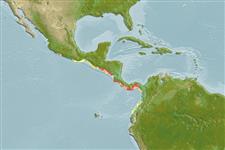Environment: milieu / climate zone / profondeur / distribution range
Écologie
marin démersal; profondeur 0 - 14 m (Ref. 92840). Tropical
Eastern Central Pacific. known only from the coast of Central America (from El Salvador to Panama, including in the Canal Zone).
Taille / Poids / Âge
Maturité: Lm ? range ? - ? cm
Max length : 5.0 cm SL mâle / non sexé; (Ref. 92840)
Description synthétique
Clés d'identification | Morphologie | Morphométrie
Distinguished by having the following characteristics: small; mottled brown and white barred color pattern; small barbels near the nostrils; pair of barbels under the chin; head and body without scales except for two enlarged basicaudal scales at the base of caudal fin (Ref. 92840).
Body shape (shape guide): elongated.
Inhabits coastal shallow environments to depths of 14 m. Found in habitats with mud or sand mixed with shell and/or rock, also in tidepools (Ref. 92840). Collected with rotenone around gorgonian covered boulders and barnacle rubble, and from scree fields which slope down to silty mud (Ref. 95098).
Life cycle and mating behavior
Maturité | Reproduction | Frai | Œufs | Fécondité | Larves
Hoese, D.F., 1995. Gobiidae. Gobios, chanquetes y guasetas. p. 1129-1135. In W. Fischer, F. Krupp, W. Schneider, C. Sommer, K.E. Carpenter and V. Niem (eds.) Guia FAO para Identification de Especies para lo Fines de la Pesca. Pacifico Centro-Oriental. 3 Vols. FAO, Rome. (Ref. 9304)
Statut dans la liste rouge de l'IUCN (Ref. 130435: Version 2025-1)
Menace pour l'homme
Harmless
Utilisations par l'homme
Outils
Articles particuliers
Télécharger en XML
Sources Internet
Estimates based on models
Preferred temperature (Réf.
123201): 27.9 - 29.1, mean 28.5 °C (based on 89 cells).
Phylogenetic diversity index (Réf.
82804): PD
50 = 0.5000 [Uniqueness, from 0.5 = low to 2.0 = high].
Bayesian length-weight: a=0.00724 (0.00339 - 0.01546), b=3.10 (2.92 - 3.28), in cm total length, based on LWR estimates for this (Sub)family-body shape (Ref.
93245).
Niveau trophique (Réf.
69278): 3.2 ±0.3 se; based on size and trophs of closest relatives
Résilience (Réf.
120179): Haut, temps minimum de doublement de population inférieur à 15 mois (Preliminary K or Fecundity.).
Fishing Vulnerability (Ref.
59153): Low vulnerability (10 of 100).
🛈
